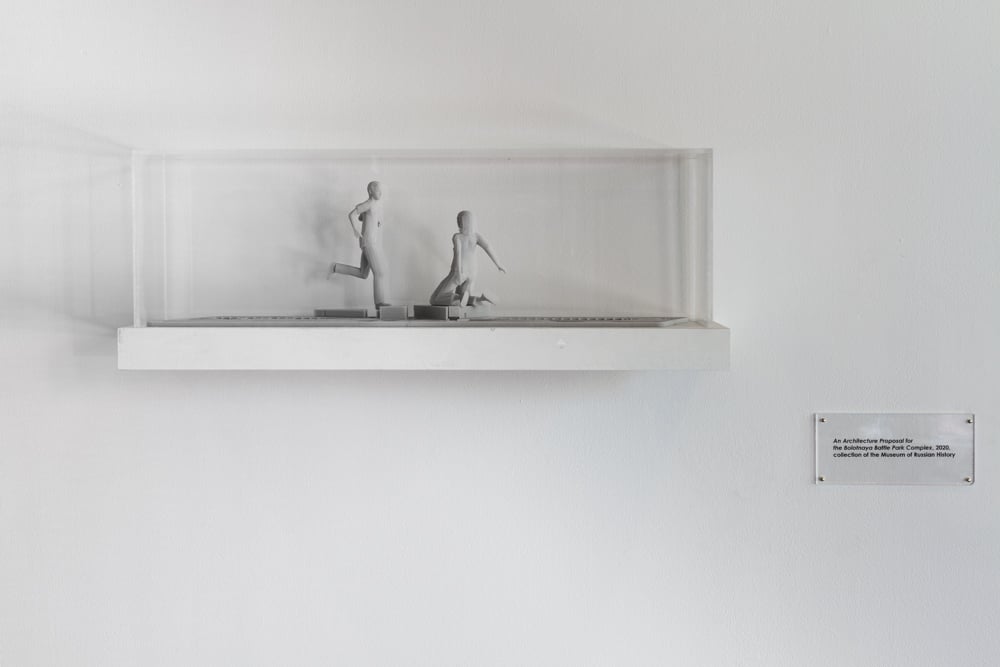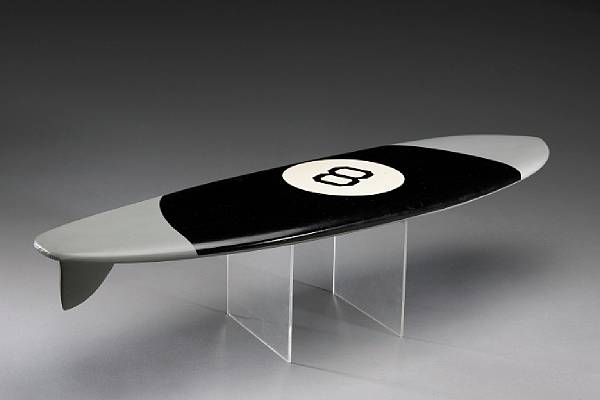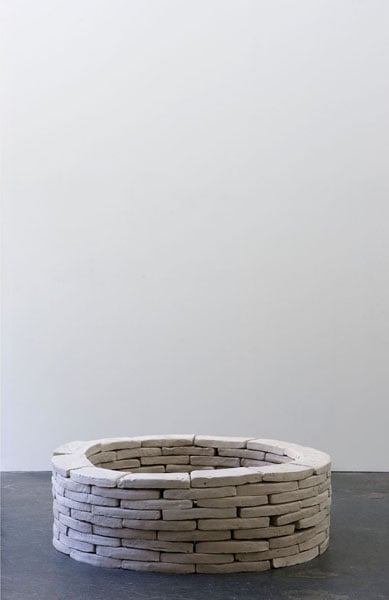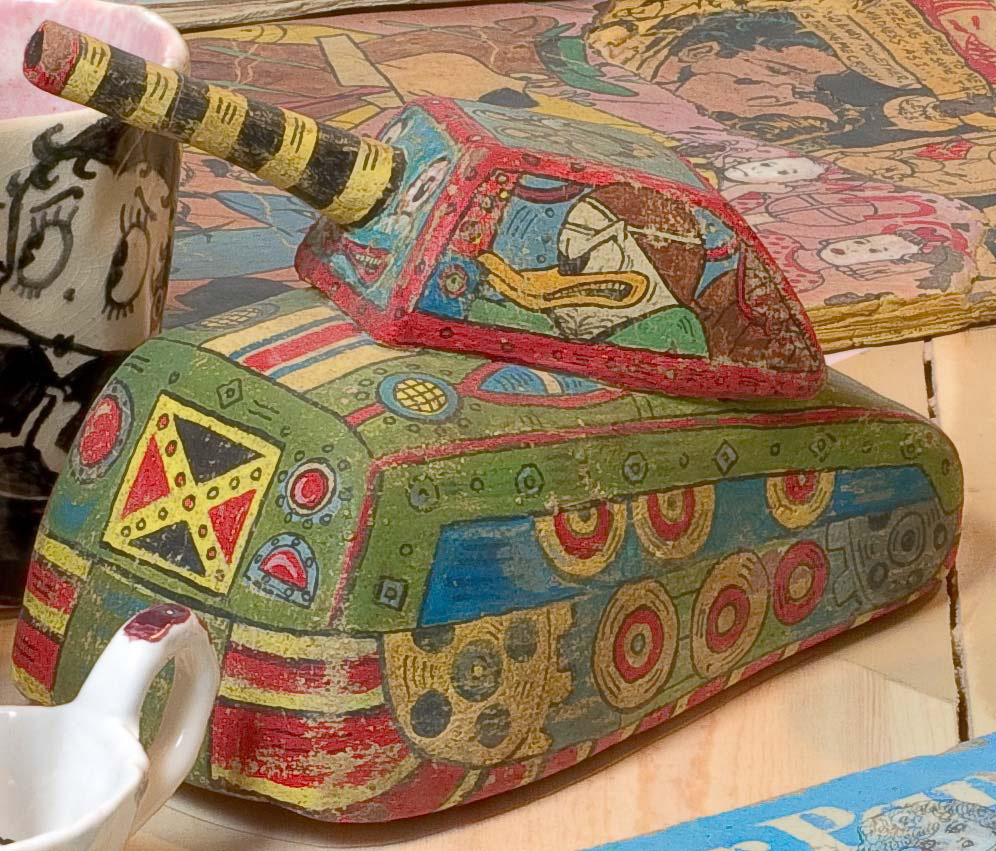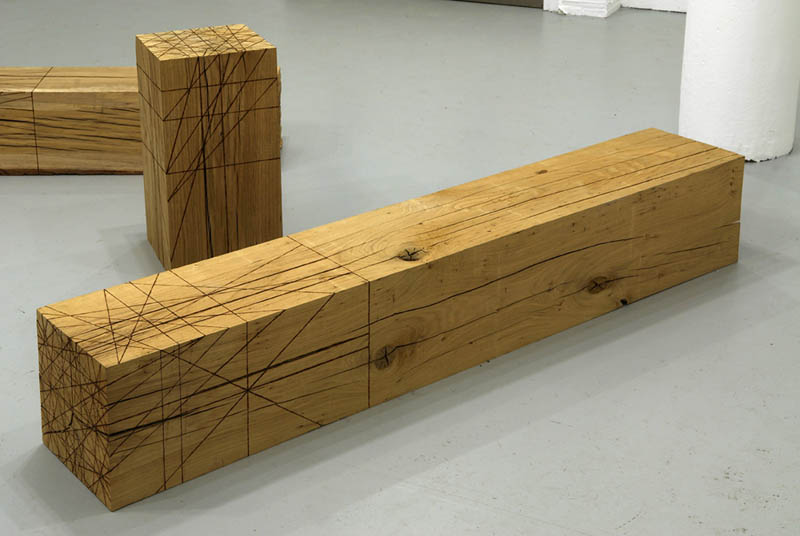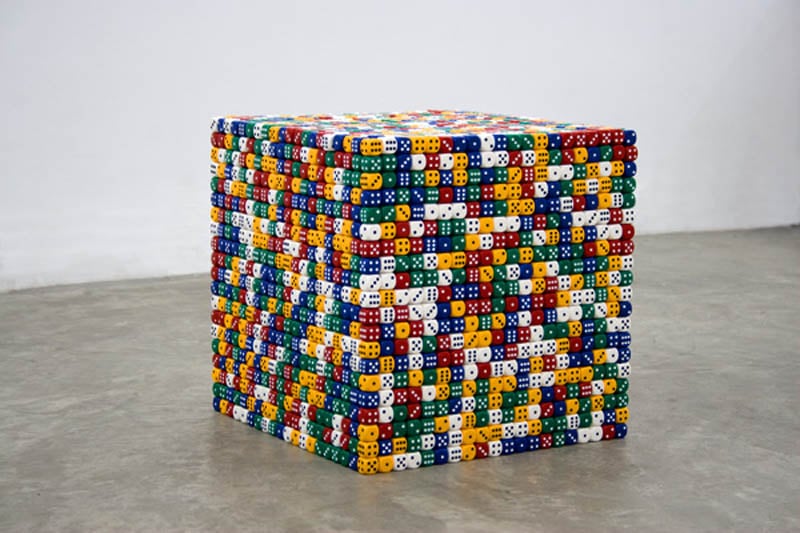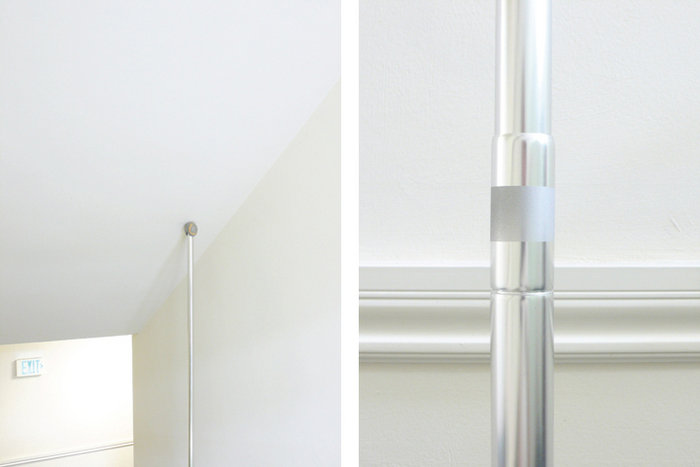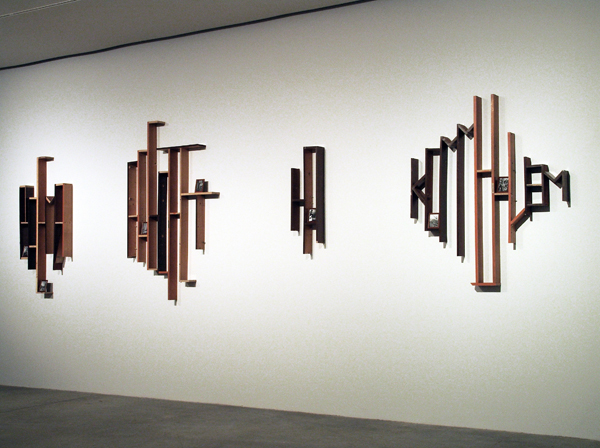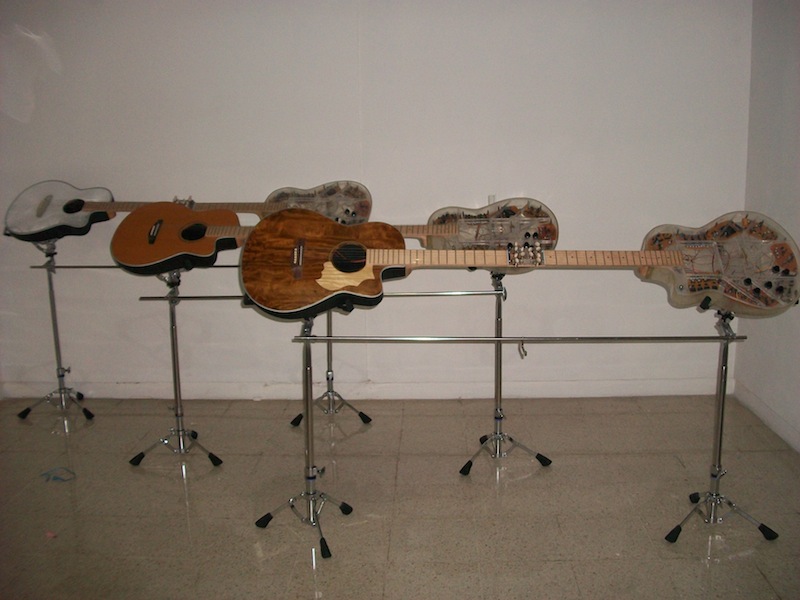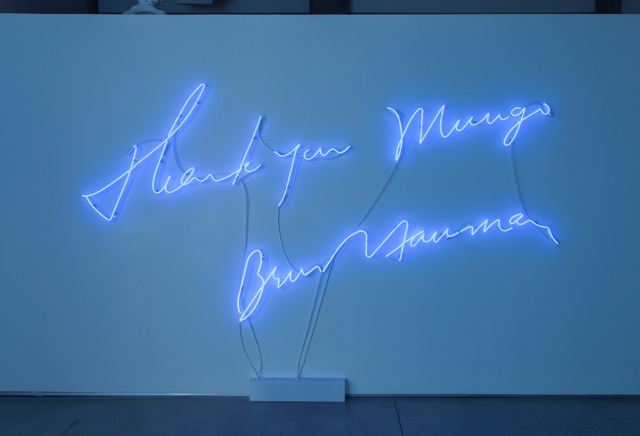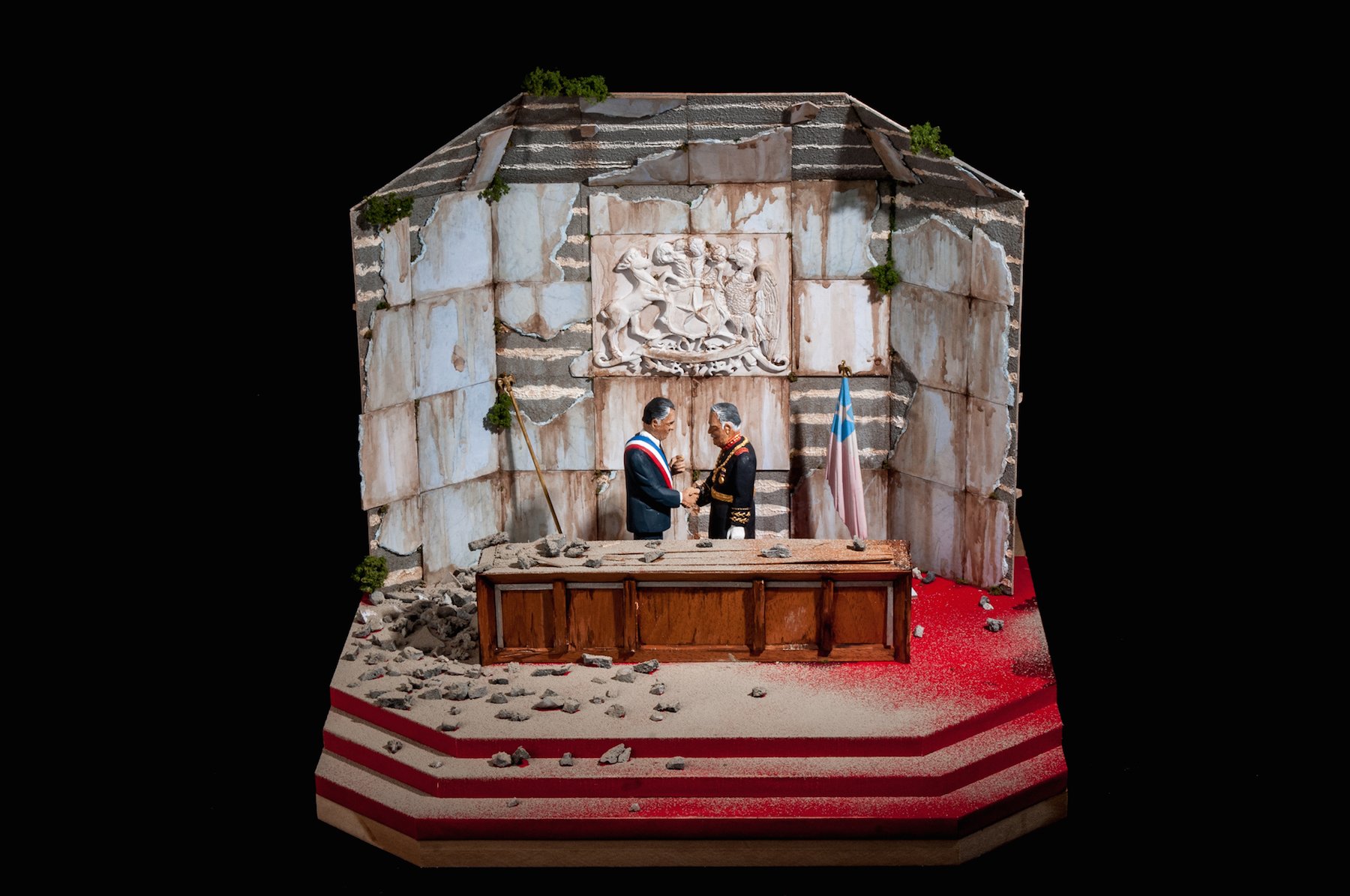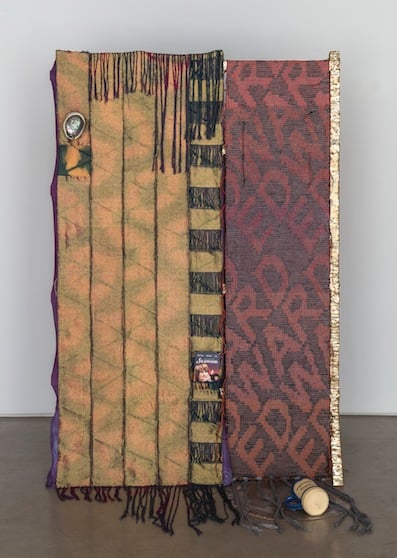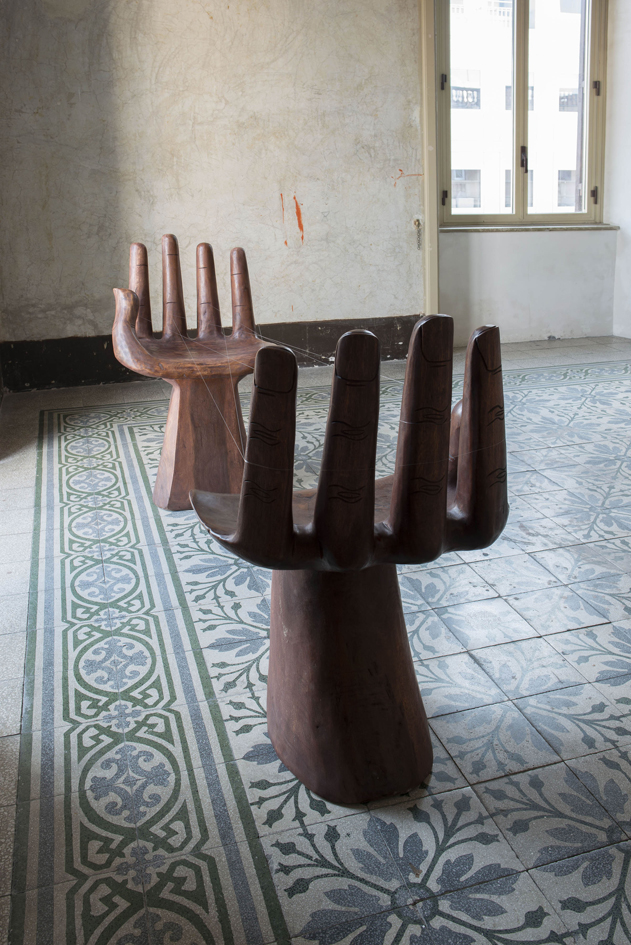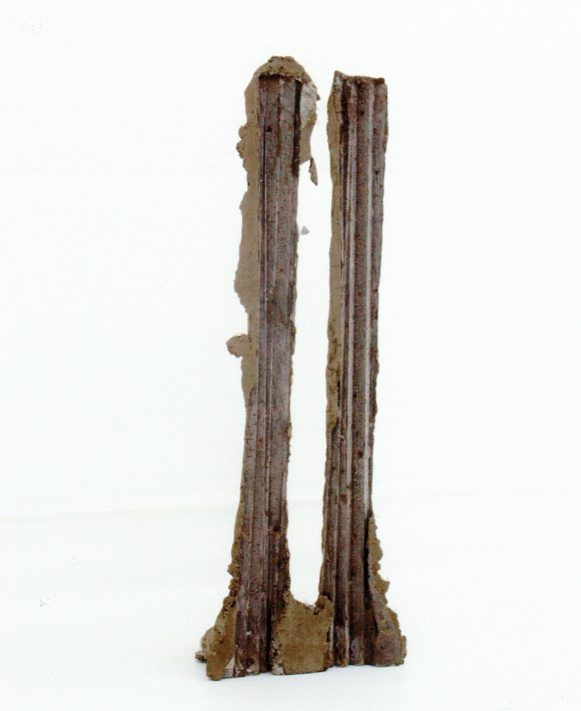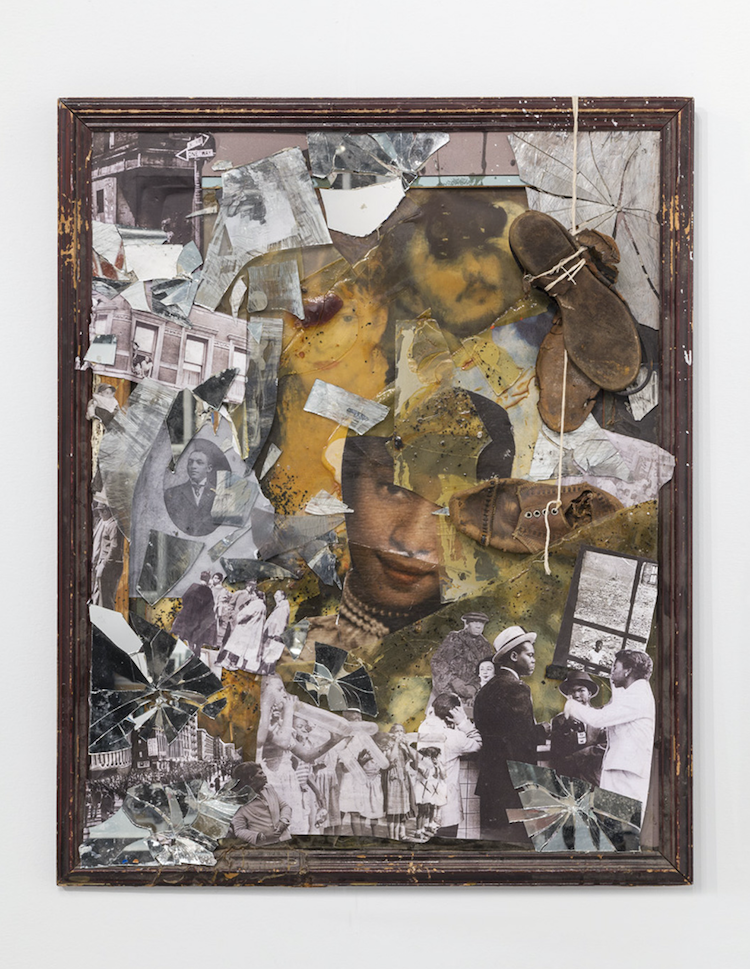
© » KADIST
Maria Fernanda Plata
Unraveling, or “unweaving” sections of fabric, Maria Fernanda Plata arrived at delicate and tenuous-looking forms, both ghostly and gentle. Her careful meditations in fabric reflect Plata’s ongoing interest in the relationship between people and their environments, in fragility, systems, and destruction.

© » KADIST
Peter Robinson
Defunct Mnemonics (2012) plays off woodworking traditions found in indigenous art in order to create a body of formally minimal objects that are both beautiful in their restraint and profoundly moving in their associations with the totemic. Resembling large pick-up-sticks, the complete work is comprised of 126 vertical sculptures wrapped in fabric with alternately monochromatic and graphically patterned dyes and prints. Leaning against a wall and arranged side-by-side, they could be mistaken as highly decorated mallets for use in an undetermined ritual or game.

© » KADIST
Doreen Lynette Garner
Known But to God: The Dug Up, Dissected, and Disposed for the Sake of Medicine by Doreen Lynnette Garner is a small, suspended sculpture composed of glass, silicone, steel, epoxy putty, pearls, Swarovski crystals, and whiskey. At once attractive and repulsive, the sculpture combines objects of adornment with what appears to be viscera. The sculpture’s curious delicacy evokes a ritualistic catharsis, in response to persistent forms of medical racial violence and objectification for Black people in America and around the world.

© » KADIST
Paul McCarthy
Memory Mistake of the Eldridge Cleaver Pants was created for the show Paul McCarthy’s Low Life Slow Life Part 1 , held at California College of the Arts’s Wattis Institute in 2008 and curated by McCarthy himself. In homage to an influence in his early career, McCarthy attempted to reconstruct a pair of pants worn by Black Panther revolutionary Eldridge Cleaver in a picture that appeared in Rolling Stone magazine in the 1970s. But in the process, McCarthy misremembered their original design of the pants, which had black outer panels and white inner panels in white, and left a black shape highlighted in the crotch area.

© » KADIST
Nazgol Ansarinia
In the early 2000s, as urban redevelopment accelerated and intense construction significantly diminished public space in Tehran, state-funded murals began to represent imaginary landscapes on building facades. The municipality of Tehran uses such pictorial representation to to exert influence over and come to terms with the flow of communal desire. The protrusion of the unreal onto the real interrupts the values, independence, and functionality of one over the other.

© » KADIST
Meschac Gaba
The headdresses, woven from artificial hair braids, symbolize historical icons including Martin Luther King, Kwame Nkrumah, Fela Kuti and King Guézo of Dahomey. The wigs portraying these grand figures also unambiguously recall Africa to mind. By declaring Cotonou, one of Benin’s cities, the Art Museum of Real Life, and by having thirty white-clad figures wearing Gaba’s latest series of tresses cross through it, he draws attention to the urban space and its inhabitants’ strategies of survival and improvisation.

© » KADIST
María Buenaventura
The Territory is not for sale is a process of reflection and research with people, thinkers and community leaders from Usme, a rural part of Bogotá on the tenuous verge of becoming urban. As an art object and installation, it comprises multiple stacks of paper each containing the decrees of land expropriation from many different peasant farmers who are being forced to sell their lots of land back to the government. Usme lies at the southern urban-rural border strategically located next to the Páramo de Sumapaz, an enormous neo-tropical tundra ecosystem and water reserve.

© » KADIST
Colter Jacobsen
Victory at Sea is a simple mechanism made from cardboard and found materials that mimics the Phenakistoscope, an early cinematic apparatus. The piece requires the viewer to turn a wheel and look through a small hole in order to see a briefly animated succession of small drawings of sailors.

© » KADIST
Jesse Krimes
Raybrook by Jesse Krimes takes its name from The Federal Correctional Institution, Ray Brook (FCI Ray Brook), a medium-security United States federal prison for male inmates located in Essex County, NY. In addition to its indexical title, this quilt-work tapestry is made from personal clothing and other like articles the artist was given by currently, and formerly incarcerated persons. It is part of a larger series of works called the Elegy Quilts , which illustrate domestic scenes inspired by conversations the artist has had with the individuals these fabrics were acquired from.

© » KADIST
Andrew Ekins
Butter Mountain is part of an ongoing series of works that combines a sense of painterly mass and substance with sculptural language to examine the synergy between a topographical landscape and a landscape of the human condition. The work intentionally alludes to the materiality of the human body and of the land. A stool has been consciously repurposed as a “support”, that by its nature and identity provides evidence of human presence.

© » KADIST
Natsuko Uchino
Squid Currency is a series of 13 non-calibrated double-sided tin coins made using a casting technique dating back to Neolithic times where cuttlebones (squid bones) were carved by hand and then used as a mold. Natsuko Uchino draws on research into tin mining across the world, which takes place largely in China and Bangladesh as well as in Potosi, Bolivia where silver has been depleted due to the production of coins and other ornate riches during the 16th century Spanish Empire. Tin has a low melting point and is easily up-cycled from vessels such as measuring cups and kitchen utensils found at yard sales.

© » KADIST
Trevor Yeung
“We both died at the same moment” is a humorous observation of anthropomorphism, the attribution of human emotions to nature and animals. A siliquaria armata is a slitworm that loosley-coiles a shell. Growing inside a sea-bed, a siliquaria armata will grow vertically until it touches another siliquaria armata, at which point they will knot together.

© » KADIST
Caspar Heinemann
Glorie #7 by Caspar Heinemann is made from cardboard boxes in which the artist received deliveries at home during lockdown, as well as other materials that he uses in an improvisatory way. Initially, Heinemann began this project by wanting to make a series of birdhouses, an interest of his that derived from walking in parks during lockdown, when bird life was so much more present as a result of the reduction in traffic noise and the absence of aircrafts. Though birdhouses may be safe spaces to nurture fledglings, they are also inherently absurd, as human constructs projected onto bird life.

© » KADIST
Erbossyn Meldibekov
Game (Six Pieces) by Erbossyn Meldibekov is inspired by the popular Rubik’s cube puzzle and is composed of three colors (red, green and white) instead of six, referencing the colors of the Afghan flag. The work provides a revisionist interpretation of the legacy of The Great Game (the original 19th-century standoff between Russian and British empires over Afghanistan), and Afghanistan’s position as a centerpiece of the longstanding War on Terror, (the military campaign led by the United States and their allies against organizations and regimes they identified as terrorists after 9/11). Game (Six Pieces) mobilizes dark humor and irony to illustrate the complex and unstable relationships between communism, Islam, and American and British imperialism.

© » KADIST
Carlos Garaicoa
From the series the Old and the New (XI) by Carlos Garaicoa belongs to the series Lo viejo y lo nuevo / Das Alte und das Neue (The Old and the New) which was first exhibited in 2010 at Barbara Gross Gallery in Germany. Here, Garaicoa’s interest in vernacular Cuban architecture shifts towards the European context: a series of twelve nineteenth-century French engravings have been reworked into delicate paper models. Here, the two-dimensional old-school architectural renderings have become the foundation for new hollow three-dimensional structures.
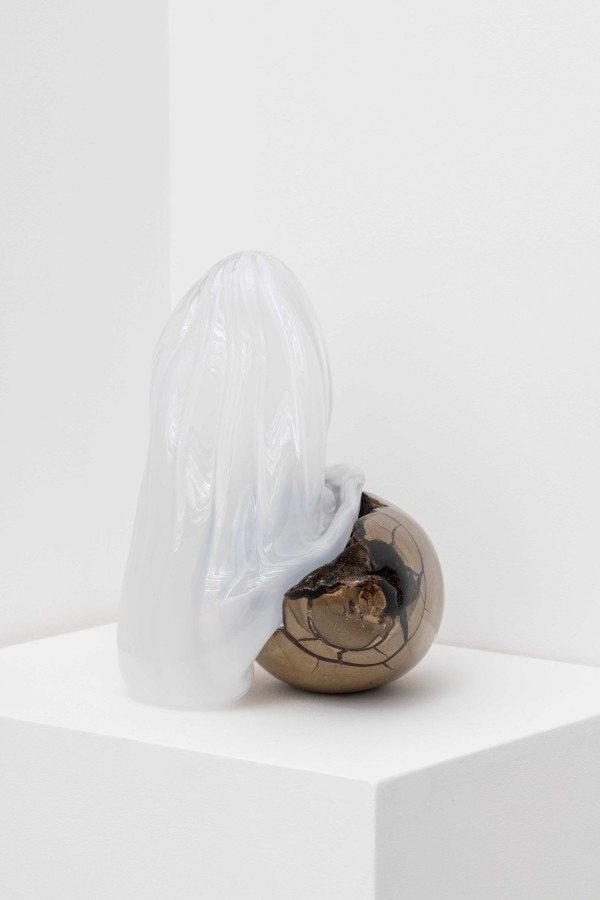
© » KADIST
Rachel Rose
First Born by Rachel Rose is part of a series of works titled Borns which expands on the artist’s longstanding interest in the organic shape of eggs. For this sculpture made of rock and glass the artist has created a milky glass-blown shape, almost like fabric in its form, which is draped over a metallic rock in the shape of an egg. For the artist, the egg is an alchemical symbol that is representative of conception and birth.

© » KADIST
John Isaacs
A child and dreamer my whole life long (broken tree) (2004) is a sculpture made of filler, wire, copper, oil paint, and wood depicting a tree just at it’s moment of breaking into half – one part alive with foliage and blooming branches and the other the crisp of the break exposed, with the trunk adhered solidly to a plinth. The sculpture appears to speak quite bluntly about Isaac’s own sense of bleak pessimism when exposing a severed tree, the universe’s sacred sign of life and birth. Through the perfect rendering of this encapsulated moment, Isaacs demonstrates the strength of the sculptural artifact and his interest in failure and fragility.

© » KADIST
Fernanda Gomes
For this floor based work, Gomes has taken two lengths of bamboo and tied them together using linen thread. The work is self-supporting and stands in a crack or a hole in the floor. The work suggests precariousness, frailty as well as humanity through its verticality, and its gentle sinuous form, referencing perhaps the work of Giacometti.

© » KADIST
Yétúndé Olagbaju
Yétúndé Olagbaju’s On becoming a star series recuperates the figure of ‘Mammy’, a stereotype rooted in American slavery that typically depicts a larger, dark skinned woman as a maternal presence, often within a domestic setting, and typically taking care of white children. After being referred to as a Mammy during their undergraduate degree, Olagbaju began exploring the figure in 2016 as a means of healing. Olagbaju’s first presentation on this topic was a book called Black Collectibles: Mammy and Friends (1997) that sells tchotchkes—like salt and pepper shakers or figurines—of the racist mammy image taking different forms, from which Olagbaju exorcised the Mammy images by carefully cutting them out of the book with a razor blade.

© » KADIST
Christopher Badger
Drowned Wood Standing Coiled (2011) consists of two sculptures, inextricably linked. In each, pieces of driftwood are bundled together vertically and entwined with rope, which cascades to the floor in a tightly wound coil. Placed side by side on the ground, these sculptures anthropomorphize into partners who are literally and figuratively bound.
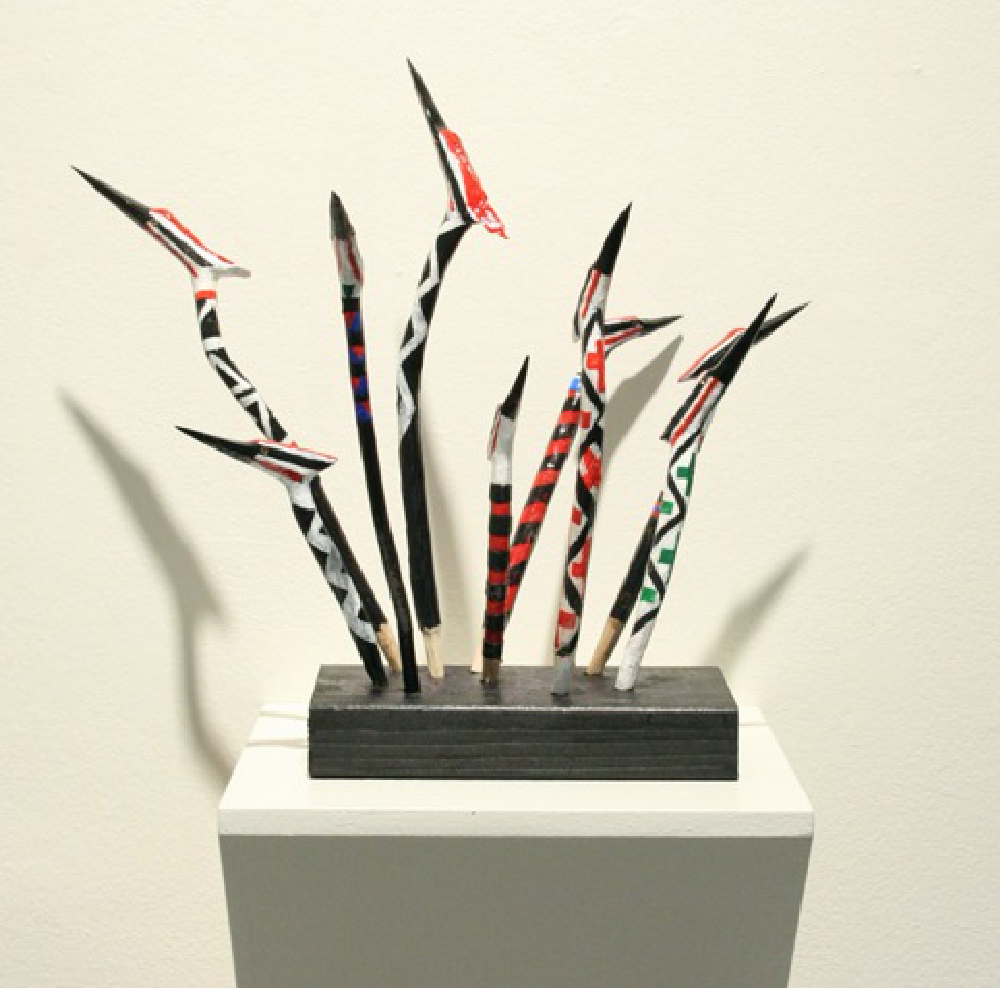
© » KADIST
Brian Tripp
For many years Tripp has been involved in reviving Karuk ceremonies that had been discontinued for decades, he developed his signature abstract style, based in Karuk design, ceremonial regalia forms, and related cultural and political iconography. The two works in the KADIST collection are a continuation of these forms with in the medium of sculpture.
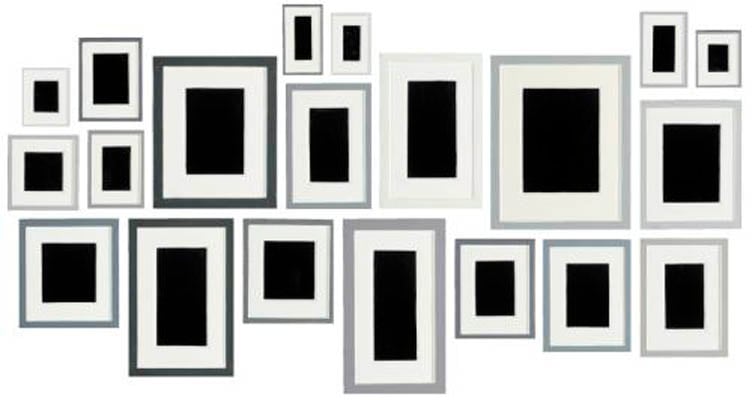
© » KADIST
Allan McCollum
In the work titled The Glossies (1980), an affinity for photography manifested itself before McCollum actually began to use photography as a medium. The Glossies are drawings, rectangular forms applied with blank ink and watercolors, which fill up the sheets parallel to the edges except for a small margin. Finally, the whole paper is covered with an adhesive plastic laminate, which gives it the shiny surface of a photograph.

© » KADIST
Judy Chicago
Domes #1 represents a significant moment in Chicago’s career when her art began to change from a New York-influenced Abstract Expressionist style to one that reflected the pop-inflected art being made in Los Angeles. By 1968, the year she began creating Domes , the twenty-nine-year-old artist had moved from Chicago to Los Angeles, graduated from UCLA, and was part of a generation of artists whose work was characterized by of the masculine overtones of Southern California’s flourishing car culture. Inspired by new technologies in the auto manufacturing, these “Finish Fetish” artists appropriated industrial materials such as car paint or lacquer to create artwork with pristine finishes.

© » KADIST
Adriana Martínez
Her 2015 work Orión is a black flag-like cloth with glow-in-the-dark symbols embroidered in the shape of the constellation. In the place of stars, Martínez has substituted the logos of international corporations and entities that use stars as their symbol; celestial navigation commanded by the logic of international corporations. Easily spotted is the smiling face of the Carl’s Jr. / Hardee’s logo, the three-pronged Mercedes-Benz emblem, Walmart’s six-pointed asterisk, and the starry cluster of the Subaru shield.

© » KADIST
Arseny Zhilyaev
His large installation entitled The Museum of Proletarian Culture (2012) looked at the changes in artistic practice that have occurred in Russia throughout the last thirty years – from the amateur art of the late Soviet era to the commercialized post-Soviet cultural practices and the more recent self-expression via contemporary social networks. Thus, the exhibition becomes a whole installation where it is impossible to distinguish architecture from assemblage, facts from fantasy, document from fiction. It is a museum of museums where viewers find themselves in the era of didactic exhibitions; whereby the main protagonists are workers, engineers, and amateur artists, and finally replaced by the creative class of 1990s and 2000s.

© » KADIST
Matthew Angelo Harrison
In Bodily Study of Unthinking Groups, Harrison combines two disparate materials into one stratified stack: automotive clay (used in detailing cars) forms the earthy base, while fragments of zebra skull become imbedded in this falsified soil. Harrison’s forged archeological artifact compresses two cultural contexts together: that of Africa, represented by the bleached zebra skull; and that of Detroit, the birthplace of the American car. Detroit’s Matthew Angelo Harrison works at the intersection of sculpture and technology, building his own 3D printers (which rise to the status of sculpture), and using these creations to formulate others.

© » KADIST
Sawangwongse Yawnghwe
22022021, Yawnghwe Office in Exile by Sawangwongse Yawnghwe belongs to a body of work made in response to the Myanmar military coup that began in February 2021. The work employs traditional Burmese textiles, which have been employed by protesters harnessing the power of old Myanmar lore. It is said that women’s bodies and the garments that cover them sap men of their power.

© » KADIST
Cildo Meireles
Meireles, whose work often involves sound, refers to Sal Sem Carne (Salt Without Meat) as a “sound sculpture.” The printed images and sounds recorded on this vinyl record and it’s lithographed sleeve describe the massacre of the Krahó people of Brazil. The piece draws on Meireles’s first-hand contact with many indigenous groups through his father’s work with the Indian Protection Service. The recordings on the LP contain narrative accounts of massacres of native peoples, as well as indigenous music and rituals.

© » KADIST
Lotus Laurie Kang
Scaffold by Lotus Laurie Kang features a seemingly disjointed amalgamation of materials between flat fabrics and lumps of aluminum. However, the simplest arcane gesture presented in the work oscillates sculptural syllabary and verse that mysteriously run through and connotes the artist’s personal, cultural, and diasporic history. Installed on the floor with a humble combination of folded burlap bags, commonly found in Korean construction sites or markets, and aluminum cast lotus roots, a common ingredient in traditional Korean cuisine.
Arseny Zhilyaev
Arseny Zhilyaev is arguably one of the most influential contemporary Russian artists of his generation...
Sawangwongse Yawnghwe
Sawangwongse Yawnghwe comes from the Yawnghwe royal family of Shan...
Prabhakar Kamble
Prabhakar Kamble is an artist, curator, and cultural activist...
Jonathan Monk
- location: Berlin, Germany
- year born: 1969
- gender: male
- nationality: British
- home town: Leicester, United Kingdom
Jason Meadows
- year born: 1972
- gender: male
- nationality: American
- home town: Indianapolis, Indiana
Mateo Lopez
- location: Bogota, Colombia
- year born: 1978
- gender: male
- nationality: Colombian
- home town: Bogota, Colombia
Jeffry Mitchell
The Seattle-based sculptor Jeffry Mitchell creates cartoonlike creatures from low-fire earthenware...
Jedediah Caesar
- location: Los Angeles, California
- year born: 1973
- gender: male
- nationality: American
- home town: Oakland, California
George Pfau
George Pfau’s work explores marginal and transitional states of being...
Cerith Wyn Evans
- location: London, United Kingdom
- year born: 1958
- gender: male
- nationality: British
- home town: Llanelli, United Kingdom
Brian Tripp
Brian D...
Alexis Smith
- location: Los Angeles, California
- year born: 1949
- gender: female
- nationality: American
- home town: Los Angeles, California
Walead Beshty
- location: Los Angeles, California
- year born: 1976
- gender: male
- home town: London, United Kingdom
Mungo Thomson
- location: Los Angeles, California
- year born: 1969
- gender: male
- nationality: American
Julio Cesar Morales
- location: San Francisco, California
- year born: 1966
- gender: male
- nationality: Mexican
- home town: Tijuana, Mexico
Mike Kelley
- location: Los Angeles, California
- year born: 1954
- gender: male
- nationality: American
- home town: Detroit, Michigan
Pia Camil
- year born: 1980
- gender: female
- nationality: Mexican
- home town: Mexico City, Mexico
Amalia Pica
- location: London, United Kingdom
- year born: 1978
- gender: female
- nationality: Argentine
- home town: Neuquén, Argentina
Julien Creuzet
The work of Julien Creuzet reveals painful stories – both personal and political – making it impossible separate one from the other...
Piero Golia
- location: Los Angeles, California
- year born: 1974
- gender: male
- nationality: Italian
- home town: Naples, Italy
Christian Salablanca
Costa Rican artist Christian Salablanca Díaz has developed a body of work around the phenomenon and experience of violence and the ways in which it generates, determines, and conditions history, society, and politics...
Yee I-Lann
- location: Kuala Lumpur, Malaysia
- year born: 1971
- gender: female
- nationality: Malaysian
- home town: Sabah, Malaysia
Taloi Havini
From the Nakas clan, Hakö people, interdisciplinary artist Taloi Havini was raised in Arawa, Autonomous Region of Bougainville...
Abraham Cruzvillegas
- location: Mexico
- year born: 1968
- gender: male
- nationality: Mexican
- home town: Mexico City, Mexico
Choi Jeong-Hwa
- year born: 1961
- gender: male
- nationality: Korean
- home town: Seoul, South Korea
Jumana Manna
Jumana Manna is a Berlin-based artist whose work revolves around the body, national identity, and historical narratives...
Subash Thebe Limbu
Subash Thebe Limbu considers his works to be science fiction through an Indigenous lens, rooted in the language, script, songs, and symbols of the Yakthung (Limbu) peoples...
-
1960-1969
Judy Chicago
1969Domes #1 represents a significant moment in Chicago’s career when her art began to change from a New York-influenced Abstract Expressionist style to one that reflected the pop-inflected art being made in Los Angeles...
-
1970-1979
Cildo Meireles
1975Meireles, whose work often involves sound, refers to Sal Sem Carne (Salt Without Meat) as a “sound sculpture.” The printed images and sounds recorded on this vinyl record and it’s lithographed sleeve describe the massacre of the Krahó people of Brazil...
-
1980-1989
Allan McCollum
1982In the work titled The Glossies (1980), an affinity for photography manifested itself before McCollum actually began to use photography as a medium...
-
1990-1999
Alexis Smith
1990Iron Sorrows (1990) brings together what are for Alexis Smith common motifs and materials such as scavenged and repurposed metal, and street signage...
Jiri Kovanda
1992Untitled (1992) responds to the same principles of an economy of means as the artist’s actions and installations: three empty cardboard boxes which have contained photographic film are piled one on top of the other...
General Idea
1993AIDS Ring by General Idea is a cast metal ring, which takes as its basis Robert Indiana’s iconic “LOVE” design, appropriating its pop aesthetic, and totalizing, simplistic universal messaging to instead emphasize the severity of the AIDS epidemic that occurred in the 1970s...
Alexis Smith
1995In 8 Ball Surfboard (1995),Alexis Smith combines her long-term interests in California culture and conceptual assemblage...
Mike Kelley
1996Towhead n’Ganga, enclosed in darkness, lorded over by the sexualized folded high priestless form reflects many of Kelley’s works, in both its compositional and semantic qualities...
-
2000-2009
Jonathan Monk
2003Untitled (rolled up) , is an abstract portrait of Owen Monk, the artist’s father and features an aluminum ring of 56.6 cm in diameter measuring 1.77 cm in circumference, the size of his father...
John Isaacs
2004A child and dreamer my whole life long (broken tree) (2004) is a sculpture made of filler, wire, copper, oil paint, and wood depicting a tree just at it’s moment of breaking into half – one part alive with foliage and blooming branches and the other the crisp of the break exposed, with the trunk adhered solidly to a plinth...
Saâdane Afif
2005In this work, Saâdane Afif quotes André Cadere’s round wooden batons using the copy share and remix principles...
Daniel Joseph Martinez
2005Martinez’s sculpture A meditation on the possibility… of romantic love or where you goin’ with that gun in your hand , Bobby Seale and Huey Newton discuss the relationship between expressionism and social reality in Hitler’s painting depicts the legendary Black Panther leaders Huey P...
Rudolf Polanszky
2005Polanszky’s sculpture is made from raw, found materials that have the patina of age...
Colter Jacobsen
2007Victory at Sea is a simple mechanism made from cardboard and found materials that mimics the Phenakistoscope, an early cinematic apparatus...
Alejandro Marré
2007Typical Weapons is a series of sculptural interventions where Alejandro Marre transforms traditional Guatemalan craft objects usually sold as souvenirs into weapons...
Piero Golia
2007Golia’s Untitled 3 is an installation in which a mechanical device is programmed to shoot clay pigeons that are thrown up in front of a white wall...
Larry Bell
2007Untitled (Construction) recalls the series of glass cubes that gained Bell international recognition in the 1960s...
Ben Shaffer
2007Ben Shaffer’s Ben Deroy (2007) is part performance, part self-portrait, and part spiritual vision...
Yoan Capote
2007Open Mind is a model created by Capote for a traversable public maze that, when seen from above, resembles the human brain...
Kristof Kintera
2007Bad innovation in the name of protection is not a ready-made, but was made entirely by the artist, representing a stroller...
Gimhongsok
2007To explore the boundaries between artwork and audience, Gimhongsok created a series of sculptural performances in which a person wearing an animal costume poses in the gallery...
Paul McCarthy
2008Memory Mistake of the Eldridge Cleaver Pants was created for the show Paul McCarthy’s Low Life Slow Life Part 1 , held at California College of the Arts’s Wattis Institute in 2008 and curated by McCarthy himself...
Takahiro Iwasaki
2008Edinburgh Castle on the Bin Bag features a model of the Edinburgh castle constructed by using shiny black cards placed on top of an open, full black plastic trash bag...
Guillaume Leblon
2008Puits (“Wells”) is a circle made ??of raw earth elements, at the scale of Leblon’s hands...
Katinka Bock
2008Like with other works of the artist, with First Piano Katinka Bock tried to go against the rules of use of clay, that is, by forcing the material to the extreme, and transferring the resulting elements into a cubic shaped volume...
Cerith Wyn Evans
2008Untitled (Perfect Lovers + 1) by Cerith Wyn Evans takes as its starting point Felix Gonzales-Torres’s seminal work Untitled (Perfect Lovers) , in which two clocks were synchronized and left to run without interference, the implication being that one would stop before the other...
Kristen Morgin
2008Donald of Doom Tank (2008) is a replica of a vintage metal toy with Donald Duck’s image one side and a soldier on the other...
Kristen Morgin
2008Jeep Comics is based on the second of only two issues published by RB Leffingwell and Company in 1944–45...
Choi Jeong-Hwa
2008The application of bright colors and kitsch materials in Flower Tree manifests a playful comment on the influence of popular culture and urban lifestyle...
Raphaël Zarka
2008Raphaël Zarka discovered the scientific manuscripts of Abraham Sharp while in Oxford...
Evariste Richer
2008Cumulocumulonimbus capillatus incus functions on the mode of a mise en abîme: it is a cube composed with 8000 dice...
Jedediah Caesar
2009For Untitled, Caesar encased recycled objects such as scraps of plywood, paper or cloth in resin and then cut and reassembled the pieces into abstract forms...
Jean-Luc Moulène
2009Head Box by J ean-Luc Moulène i s not the representation of a space but a real space that remains in the domain of sculpture which the artist develops in parallel with his photographic practice...
Jason Meadows
2009The Striation Scrap Lamps (vertical and horizontal) although functioning as utilitarian objects also represent Jason Meadows’s interest in a certain kind of crafted sculpture...
Yang Xinguang
2009Although seemingly unadorned at first glance, Yang Xinguang’s sculptural work Phenomena (2009) employs minimalist aesthetics as a means of gesturing towards the various commonalities and conflicts between civilization and the natural world...
Shilpa Gupta
2009In Untitled (Sword) , addressing histories of colonialism with abstraction, a large steel blade extends from the gallery wall...
-
2010-2019
Meschac Gaba
2010The headdresses, woven from artificial hair braids, symbolize historical icons including Martin Luther King, Kwame Nkrumah, Fela Kuti and King Guézo of Dahomey...
Carlos Garaicoa
2010From the series the Old and the New (XI) by Carlos Garaicoa belongs to the series Lo viejo y lo nuevo / Das Alte und das Neue (The Old and the New) which was first exhibited in 2010 at Barbara Gross Gallery in Germany...
Brian Tripp
2010For many years Tripp has been involved in reviving Karuk ceremonies that had been discontinued for decades, he developed his signature abstract style, based in Karuk design, ceremonial regalia forms, and related cultural and political iconography...
Haegue Yang
2010In addition to Yang’s signature drying rack and light bulbs, Office Voodoo includes various office supplies like CDs, paper clips, headphones, a computer mouse, a stamp, a hole puncher, a mobile phone charger...
Thea Djordjadze
2010The sculpture And Shadows Will Follow is an angle piece that articulates a space since its appearance highly changes depending on the point of view...
Marcelo Cidade
2010Marcelo Cidade’s sculpture Abuso de poder (Abuse of Power, 2010) is a mousetrap elegantly crafted in Carrara marble...
Chadwick Rantanen
2010Telescopic Pole is an adjustable telescopic pole that extends vertically from floor to ceiling and is held up by its own internal pressure...
Futurefarmers
2010Erratum: Brief Interruptions in the Waste Stream exists as performance, sculpture, drawing, video and the printed word...
Jedediah Caesar
2010After being cast, the resulting resin block used in JCA-25-SC was cut into thin slices obtaining a series of rectangular shapes that resemble ceramic tiles...
Takahiro Iwasaki
2010Tectonic Model is made from a number of leather bound books piled up in different formations that resemble architecture on top of a sawhorse desk...
Brian Tripp
2010For many years Tripp has been involved in reviving Karuk ceremonies that had been discontinued for decades, he developed his signature abstract style, based in Karuk design, ceremonial regalia forms, and related cultural and political iconography...
Arseny Zhilyaev
2010Arseniy Zhilyaev (born 1984 in Voronezh, Russia) is an artist, writer and political activist who lives and works in Moscow and Voronezh...
María Buenaventura
2011The Territory is not for sale is a process of reflection and research with people, thinkers and community leaders from Usme, a rural part of Bogotá on the tenuous verge of becoming urban...
Christopher Badger
2011Drowned Wood Standing Coiled (2011) consists of two sculptures, inextricably linked...
Jason Meadows
2011Titled afterTruman Capote’s protagonist famously played by Audrey Hepburn in the film Breakfast at Tiffany’s (1961), Holly Golightly (2011) captures the essence of the character: seductive and bold, mysterious and capricious...
Venzha Christ
2011The installation work Men from Hyperion and Women from Phoebe (2011), for examples, features six guitars mounted on steel crossbar stands and connected to one another with slack wires...
Walead Beshty
2011Constructed out of metal or glass to mirror the size of FedEx shipping boxes, and to fit securely inside, Walead Beshty’s FedEx works are then shipped, accruing cracks, chips, scrapes, and bruises along the way to their destination...
Pablo Accinelli
2011In Onde quer que voce esteja (2011) Accinelli sets up a row of cardboard shipping tubes of varying heights and inscribes on them in black ink the words of the title, which translates in English as “Wherever you may be.” The words, while legible, seem like fragmented lines and shapes—almost but not quite a deconstruction of the text...
Engel Leonardo
2011As with so many other colonized geographies, the ways in which violence has become a natural and expected component of Santo Domingo reflects the forced friendship between the beneficiaries and residues of Modernism...
Vidya Gastaldon
2011Gastaldon has made a number of soft sculptures using materials associated with knitting and sewing that have alternately fetishistic, nightmarish or contemplative qualities...
Jason Meadows
2011Jason Meadows’s Do Not Pass Go (2011) depicts Richie Rich, “the poor little rich boy” of the 1950s comic strip...
Peter Robinson
2012Defunct Mnemonics (2012) plays off woodworking traditions found in indigenous art in order to create a body of formally minimal objects that are both beautiful in their restraint and profoundly moving in their associations with the totemic...
Juan Capistran
2012The 10 $1 bills that make up From a Whisper to a Scream (2012) read like instructions in origami...
Walead Beshty
2012Constructed out of metal or glass to mirror the size of FedEx shipping boxes, and to fit securely inside, Walead Beshty’s FedEx works are then shipped, accruing cracks, chips, scrapes, and bruises along the way to their destination...
Nicolás Paris
2012Nicolas Paris studied architecture and worked as an elementary school teacher before he decided to become an artist...
Aki Sasamoto
2012Poetry Light Stool evokes the spirit of Fluxus, the intermedia movement that encouraged artmaking to be simple, fun, and address everyday life...
Amy Balkin
2012Data mining is a computer software process that can involve the neutral or benign analyzing of internet data for patterns, however, it can also imply the more sinister activities of surveillance or subject-based information gathering...
Mateo Lopez
2012With Roca Carbón (Charcoal Rock, 2012) and Roca Grafito ( Graphite Rock , 2012), López plays with our relationship to inert and unremarkable objects such as rocks...
Jeffry Mitchell
2012Poised with tool in hand, Jeffry Mitchell’s The Carpenter (2012) reaches forward, toward his workbench...
Mateo Lopez
2012With Roca Carbon ( Charcoal Rock , 2012) and Roca Grafito ( Graphite Rock , 2012), López plays with our relationship to inert and unremarkable objects such as rocks...
James T. Hong
2012Taiwan WMD (Taiwan and Weapons of Mass Destruction) is part of a long-term research started in early 2010 on the history and aftermath effects of Japanese biological and chemical warfare in China during WWII, as well as the unknown history of Taiwan’s nuclear program...
Diane Simpson
2012Simpson’s sculptural practice connects architecture, clothing, furniture and the body to explore the functional and sociological roles and the influence of the design and architecture of various cultures and periods in history...
Nazgol Ansarinia
2013In the early 2000s, as urban redevelopment accelerated and intense construction significantly diminished public space in Tehran, state-funded murals began to represent imaginary landscapes on building facades...
Fernanda Gomes
2013For this floor based work, Gomes has taken two lengths of bamboo and tied them together using linen thread...
Rometti Costales
2013This anarchist flag is made from Huayruro seeds, a native plant of South and Central American tropical areas...
Burak Delier
2013Burak Delier’s sculpture Homage to Balotelli’s Missed Trick is a symbol of resistance to the demand for success and performance...
Amalia Pica
2013Memorial for intersections #2 (2013) is a minimalist, black metallic structure that contains the brightly colored translucent circles, triangles, rectangles, and squares that originally were presented in Pica’s performance work A ? B ? C (2013)...
Anna-Bella Papp
2013Untitled exemplifies the format that Anna Bella-Papp most commonly works in, using her hands to create delicate tablet-like reliefs within a rectangular form made out of clay...
Trevor Yeung
2014“We both died at the same moment” is a humorous observation of anthropomorphism, the attribution of human emotions to nature and animals...
Oscar Tuazon
2014Oscar Tuazon‘s sculptural oeuvre is situated at the border of art, architecture and technology...
Thiago Honório
2014Pau-Brasil is a sculpture by Thiago Honório that references Oswald de Andrade’s 1925 classic of Brazilian modernist literature of the same title...
Teppei Kaneuji
2014In his White Discharge series (2002 to today), arguably his best known works, Kaneuji assembles old toys and plastic scarps into dramatic mounded heaps and covers the surface with white plastic resin, drawing on allusions to landfills, commodity fetishism, and creative repurposing...
Nicolás Grum
2014El gran pacto de Chile (The Great Pact) and La balserita de Puerto Gala (The Raft) were part of the “Museo Futuro”, an exhibition in which the artist presented nine miniature dioramas staging fragments of Chile’s history, from its colonial invasions to the present...
Little Warsaw
2014Jaali – Horizontal references religious practices in Hungary that were considered as a civil disobedience throughout the 1950s...
Adriano Costa
2014Westminster Agua Viva is made from Westminster City Council(‘s) recycling bin bags, glued together, that the artist has painted and cut or cut and painted...
Elena Damiani
2014In Fading Fields 7 by Elena Damiani, the unstable transparency of the print on silk chiffon is relative to the light and the viewer’s position, varying continually as one moves around the work...
Mungo Thomson
2014Starting with Bruce Nauman’s iconic artwork, The True Artist Helps the World by Revealing Mystic Truths (Window or Wall Sign) , Mungo Thomson’s neon sign is one of a series that replaces Nauman’s quixotic mini-manifesto with aphorisms from ‘recovery’ culture, especially those made popular by alcoholics anonymous...
Josh Faught
2014Some of Faught’s works have been inspired by the ad hoc monuments created at gravesites in San Francisco’s Neptune Society Columbarium, where many victims of the AIDS epidemic were laid to rest...
Nicolás Grum
2014El gran pacto de Chile (The Great Pact) and La balserita de Puerto Gala (The Raft) were part of the “Museo Futuro”, an exhibition in which the artist presented nine miniature dioramas staging fragments of Chile’s history, from its colonial invasions to the present...
Ximena Garrido Lecca
2014Destilaciones ( Distillations , 2014) is an installation composed of a group of ceramic pots, presented on the floor and within a steel structure...
Adriana Lara
2014Lara uses things readily at hand to create objects and situations that interrogate the processes of art and the spectrum of roles that art and artists play in society...
Nicolás Consuegra
2014Consuegra’s Colombia is a mirror made in the shape of the artist’s home country—a silhouette that has an important resonance for the artist...
Maria Fernanda Plata
2015Unraveling, or “unweaving” sections of fabric, Maria Fernanda Plata arrived at delicate and tenuous-looking forms, both ghostly and gentle...
Adriana Martínez
2015Her 2015 work Orión is a black flag-like cloth with glow-in-the-dark symbols embroidered in the shape of the constellation...
Candice Lin
2015For the work Wigan Pit-Brow Women: Intersections with the Caribbean (mobile) , Candice Lin studied English Victorian Arthur Munby’s racialized and masculinized drawings of working-class white female miners...
Mariana Castillo Deball
2015Taking archaeology as her departure point to examine the trajectories of replicated and displaced objects, “Who will measure the space, who will tell me the time?” was produced in Oaxaca for her exhibition of the same title at the Contemporary Museum of Oaxaca (MACO) in 2015...
Taloi Havini
2015Following her family’s political exile to Australia in 1990, Havini began to document her journey’s home to the north of Buka Island, in the Autonomous Region of Bougainville...
Jumana Manna
2015Blue Elbow (Coude bleu) is made from plaster, burlap, lacquer, pigments and plastics...
Shahryar Nashat
2015Employing both the High Modernist technique of abstraction and monochronism, as in the work of Lucio Fontana and Yves Klein, and bodily states of fetishization, Yea High (sweetpreparator) reworks the art historical canon of movement and the body to consider flesh as a physical construction of man-made matter...
Andrea Bowers
2015Bowers’ Radical Hospitality (2015) is a sculptural contradiction: its red and blue neon letters proclaim the words of the title, signaling openness and generosity, while the barbed wires that encircle the words give another message entirely...
Adriana Martínez
2015Her work Al final del arcoiris (At the end of the rainbow, 2015) is a bundle of bills from Chile, Venezuela, Brazil, Colombia, Nicaragua, and Costa Rica, arranged by color to form a tight spiraling rainbow held close with a rubber band...
Matthew Angelo Harrison
2016In Bodily Study of Unthinking Groups, Harrison combines two disparate materials into one stratified stack: automotive clay (used in detailing cars) forms the earthy base, while fragments of zebra skull become imbedded in this falsified soil...
Renata Lucas
2016Lucas’s quadroquadro (círculo) employs familiar materials for the artist: wood, paper, and glass...
Joaquín Segura
2016Pyre , an installation by Mexico City-based artist Joaquín Segura, addresses corruption, impunity, and the role that failed governments play in the normalization of violence...
Nicholas Buffon
2016A series of works from 2016 document his neighborhood, replicating buildings and businesses he frequents within four blocks of his New York apartment...
Doreen Lynette Garner
2017Known But to God: The Dug Up, Dissected, and Disposed for the Sake of Medicine by Doreen Lynnette Garner is a small, suspended sculpture composed of glass, silicone, steel, epoxy putty, pearls, Swarovski crystals, and whiskey...
Erbossyn Meldibekov
2017Game (Six Pieces) by Erbossyn Meldibekov is inspired by the popular Rubik’s cube puzzle and is composed of three colors (red, green and white) instead of six, referencing the colors of the Afghan flag...
Curtis Talwst Santiago
2017Curtis Talwst Santiago has been creating intimate and performative environments within these small spaces for several years; the artist used to carry them around to show visitors one on one, opening up a scene in the space of his hand...
Juliana Huxtable
2017Herculine’s Prophecy by Juliana Huxtable features a kneeling demon-figure on what appears to be a screen-print, placed on a wooden table, which has then been photographed and digitally altered to appear like a book cover, with a title and subtitle across the top, and a poem written across the bottom...
Ali Cherri
2017As a discipline born at the same time as colonialism, archeology is struggling to rid itself of this sad context...
Daniel Boccato
2017Birdstones is a series of flat concrete slabs made from moldings of different shapes, each with two small holes...
Mika Tajima
2017Mika Tajima’s Pranayama sculptures are built from carved wood and chromed Jacuzzi jets and are presented as artefacts...
Abigail DeVille
2017The work La Loge Harlem focuses on the history of Harlem and its development over the last 200 years...
Beverly Buchanan
2017Made between 1986 and 2015, Buchanan’s Shack Sculptures are a result of the artist’s close observation and extensive research of ‘shotgun’ houses, where one room is arranged in sequence one behind the other; the rural poor inhabited these houses...
Antonio Pichillá
2017Wind by Antonio Pichillá is a textile piece depicting the glyph that represents the element wind in the Mayan tradition...
Andrew Ekins
2018Butter Mountain is part of an ongoing series of works that combines a sense of painterly mass and substance with sculptural language to examine the synergy between a topographical landscape and a landscape of the human condition...
Judith Hopf
2018Hopf’s works reference the effects that developments in economics and technology have had on our bodily and mental composition...
Anne Samat
2018Anne Samat’s Puteri 3 references Ulek Mayang, a classical Malay dance, performed in a ritualistic pre-Islamic context...
Auriea Harvey
2018Fauna is a figurative sculpture by Auriea Harvey that is characteristic of the artist’s practice—both serious and somewhat whimsical...
Naufus Ramírez-Figueroa
2018In Guardian 2 Naufus Ramírez Figueroa explores the historical memory and political reality of the ruins of Kawinal, an archeological site of postclassic Mayan culture that was flooded in order to construct the hydroelectric dam of Chixoy in 1975 in a supposed effort to bring electricity to the country...
Marguerite Humeau
2018This work forms part of a project that draws upon research into the use of psychoactive substances present in animal brains during the Paleolithic period...
Mélanie Matranga
2018My Shape (2018) is the final work of the exhibition “Sorry”, taking the form of a Levi’s denim jacket pattern, expanded three or four times larger than its original shape...
Jota Mombaça
2018The performance title A Gente Combinamos De Não Morrer (BANDEIRA #1) / Us Agreed Not To Die (FLAG #1) is taken from a short story by Brazilian writer Conceição Evaristo, whose work addresses violence, resilience, and necropolitics with an Afro-diasporic lens...
Nadia Myre
2018First exhibited as part of the recent multidisciplinary project Code Switching and Other Work , at Art Mûr, Berlin in late 2018, Nadia Myre’s Untitled (Tobacco Barrel) takes inspiration from the cylindrical vessels used to import tobacco from North America to Europe during periods of early colonial settlement...
Rachel Rose
2019First Born by Rachel Rose is part of a series of works titled Borns which expands on the artist’s longstanding interest in the organic shape of eggs...
Claudia Martínez Garay
2019escenario chacana by Claudia Martínez Garay is a sculptural work composed of a frame-like structure that contains a series of ceramic pieces...
Erin Jane Nelson
2019In Erin Jane Nelson’s 2019 body of work Av, panels are covered in collaged images and shellacked with resin or epoxy: photographs of plants intermingle with pictures of men and women engaging in various spiritual activities, cartoons of mothers and their children, or black and white images of window panes...
Mazenett Quiroga
2019Gente Serpiente (Serpent People) is a piece made with the wheels of bikes, twisted, intertwined and painted like skins of tropical poisonous snakes...
Diego Bianchi
2019Diego Bianchi’s main concern is distorting straight lines, both literally and metaphorically...
Gabriel Chaile
2019For the project Aguas calientes Gabriel Chaile exchanged silverware from three popular soup kitchens (mutual aid organizations to provide food for people in need) in Buenos Aires to brand new cooking utensils to shape his project...
Ryan Villamael
2019Behold A City 4 extols the old grandeur of Manila, the nation’s storied capital – the complex nexus of heritage, modernity, and all sorts of compulsions, political or otherwise, that attempt to define it...
Jorge Satorre
2019In 1872, a German scientist, Sir Julius von Haast, found the fossilized remains of a giant bird in New Zealand, that was soon connected to the Maori legend of the Hokioi...
American Artist
2019From suicides, to gang violence, to the epidemic abuse of force by police departments (predominantly against Black men), to school and mass shootings, there is perhaps no more urgent issue in the United States than gun control...
Leelee Chan
2019Blindfold Receptor (caterpillar-yellow) by Leelee Chan is inspired by the camouflaging nature of the peppered-moth caterpillar...
-
2020-2029
Jesse Krimes
2020Raybrook by Jesse Krimes takes its name from The Federal Correctional Institution, Ray Brook (FCI Ray Brook), a medium-security United States federal prison for male inmates located in Essex County, NY...
Natsuko Uchino
2020Squid Currency is a series of 13 non-calibrated double-sided tin coins made using a casting technique dating back to Neolithic times where cuttlebones (squid bones) were carved by hand and then used as a mold...
Duane Linklater
2020silentstar, delicacy by Duane Linklater is a replica of a baby pink hoodie that the artist wore as a teenager, embellished with hand-painted elements and band patches...
Oren Pinhassi
2020Oren Pinhassi’s work examines the relationship between the human figure and the built environment...
Paloma Contreras Lomas
2020Paloma Contreras Lomas has frequently used animals as metaphors in her work...
Yee I-Lann
20207-headed Lalandau Hat by Yee I-Lann is an intricately woven sculpture evoking the ceremonial headdress worn by Murut men in Borneo...
Nikita Gale
2020RUINER III by Nikita Gale is part of an on-going numbered series of abstract sculptures in which various ancillary materials necessary for sound production and recording such as towels, foam, and audio cables, are riddled around piping resembling crowd control bollards, lighting trusses, and other like stage architecture...
Sable Elyse Smith
2020Sable Elyse Smith’s Pivot III resembles playground equipment uselessly reconfigured...
Xolo Cuintle
2020In a post-apocalyptic setting, a layer of dust petrifies everything in an eternal state of latency...
Yétúndé Olagbaju
2021Yétúndé Olagbaju’s On becoming a star series recuperates the figure of ‘Mammy’, a stereotype rooted in American slavery that typically depicts a larger, dark skinned woman as a maternal presence, often within a domestic setting, and typically taking care of white children...
Sawangwongse Yawnghwe
202122022021, Yawnghwe Office in Exile by Sawangwongse Yawnghwe belongs to a body of work made in response to the Myanmar military coup that began in February 2021...
Christian Salablanca
2021Hueso de culebra (Snake Bone) arises from the stories that the artist’s grandmother used to tell him as a child about her father’s medical and spiritual practices in the southern part of Costa Rica, close to the border with Panama...
Subash Thebe Limbu
2021In Ningwasum , Subash Thebe Limbu explores Adivasi Futurism, a concept he has developed over a number of years, inspired by the writings of Octavia Butler, Afrofuturism, Indigenous Futurism, and various Adivasi, Janajati, feminist, queer, and Dalit movements...
Sawangwongse Yawnghwe
202122022021, Yawnghwe Office in Exile by Sawangwongse Yawnghwe belongs to a body of work made in response to the Myanmar military coup that began in February 2021...
Rajni Perera
2021Drought Mask by Rajni Perera is a prototype that is suggestive of dire implications for human survival...
Phoebe Collings-James
2021The Subtle Rules the Dense is a series of masks/torsos/body plates that Phoebe Collings-James cast from mannequins and then worked by hand...
Pichet Piaklin
2021The Wings by Pichet Piaklin is a creation story of fragility, where the desire for freedom is mired in blood red by the inculcation of faith and violence...
Sawangwongse Yawnghwe
202122022021, Yawnghwe Office in Exile by Sawangwongse Yawnghwe belongs to a body of work made in response to the Myanmar military coup that began in February 2021...
Sawangwongse Yawnghwe
202122022021, Yawnghwe Office in Exile by Sawangwongse Yawnghwe belongs to a body of work made in response to the Myanmar military coup that began in February 2021...
Sawangwongse Yawnghwe
202122022021, Yawnghwe Office in Exile by Sawangwongse Yawnghwe belongs to a body of work made in response to the Myanmar military coup that began in February 2021...
Sawangwongse Yawnghwe
202122022021, Yawnghwe Office in Exile by Sawangwongse Yawnghwe belongs to a body of work made in response to the Myanmar military coup that began in February 2021...
Caspar Heinemann
2022Glorie #7 by Caspar Heinemann is made from cardboard boxes in which the artist received deliveries at home during lockdown, as well as other materials that he uses in an improvisatory way...
Lotus Laurie Kang
2022Scaffold by Lotus Laurie Kang features a seemingly disjointed amalgamation of materials between flat fabrics and lumps of aluminum...
Jota Mombaça
2022Ghost 1: Drowning is not a poem but is not not a poem either by Jota Mombaça is part of a series of sculptures exploring water’s restless, elemental properties and what the artist describes as “the radicality of sinking”...
Antonio Vega Macotela
2022The mines at Potosí are both the site and subject of this work, also titled Potosí, by Antonio Vega Macotela...
Prabhakar Kamble
2022To produce the series of sculptures collectively titled Utarand , Prabhakar Kamble relocated his studio to Kolhapur, Maharashtra, near the village where he was born into a family of daily wage earners...
Prabhakar Kamble
2022To produce the series of sculptures collectively titled Utarand , Prabhakar Kamble relocated his studio to Kolhapur, Maharashtra, near the village where he was born into a family of daily wage earners...
Guadalupe Rosales
202290022 (Leonard Ave) by Guadalupe Rosales engages with memory, loss, grief, and nostalgia; themes that run throughout the artist’s practice...
Prabhakar Kamble
2022To produce the series of sculptures collectively titled Utarand , Prabhakar Kamble relocated his studio to Kolhapur, Maharashtra, near the village where he was born into a family of daily wage earners...
Pratchaya Phinthong
2022Pratchaya Phinthong’s work has explored the mineral and karmic economies of Laos, a country that shares language, beliefs, and a long border with his own native region of Isaan (Northeast Thailand)...
Helina Metaferia
2023By Way of Revolution is a series that addresses the inherited histories of protest that inform contemporary social movements...

